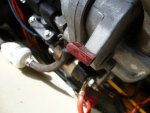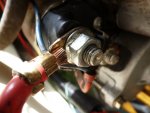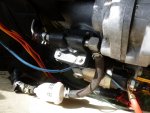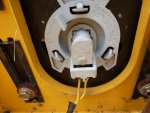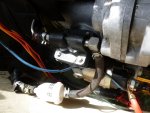I have the Kohler CH13S engine. The mower will not start unless I bridge the bolts on the solenoid ... unfortunately the PTO will not engage while running. I unhooked the wire that goes to the solenoid to check for cuurent. With the key on I put the + probe on the wire clip and the - on the battery. I got no reading. Is this lack of current why the PTO won't engage?:thumbdown: What do I need to do to correct this problem. Thank you for reading my post.
You are using an out of date browser. It may not display this or other websites correctly.
You should upgrade or use an alternative browser.
You should upgrade or use an alternative browser.
Repairs Cub Cadet 2135 No Current To Solenoid
- Thread starter spirittoo
- Start date
More options
Export threadUpdate
I took my multimeter set it for current readings. I put the positive probe into the clip of the blue wire, put the neg. probe on the battery. I started the engine by bridging the solenoid. I didn't get a reading. Volt reading was .561. I tried checking the seat safety by removing the two wires with clips attached and bridged them together using a clip, but it still would not start ... did I over ride that correctly?:ashamed:
I took my multimeter set it for current readings. I put the positive probe into the clip of the blue wire, put the neg. probe on the battery. I started the engine by bridging the solenoid. I didn't get a reading. Volt reading was .561. I tried checking the seat safety by removing the two wires with clips attached and bridged them together using a clip, but it still would not start ... did I over ride that correctly?:ashamed:
Attachments
First, fix that blue wire, second reattach all safety switches. LawnRanger and I put together this procedure to troubleshoot starting problems. Follow it carefully and report back. Then we can tell you how to proceed. Do not skip any steps and work slowly.
I wrote this procedure with tractor style mowers in mind but this works on zero turn mowers as well. For a zero turn mower, the steering levers must be out, parking brake engaged and the PTO switch in the off position. Some mowers have an operator presence switch in the seat and you may need an assistant to sit in the seat while performing the following tests.
Electrical problems can be very easy or very difficult, depending on four things:
1. How well you understand basic electricity.
2. What tools you have and know how to use.
3. How well you follow directions. Ahem.
4. You don't overlook or assume anything and test/verify everything.
First you need to check every wire and connection, making sure they are not dirty, corroded, broken or loose. *Failure to do this can lead to inaccurate reading or tests down the road.
Remember, I cannot see what you are doing. You are the eyes, ears and fingers in solving this problem. You must be as accurate as you can when you report back. The two basic tools I will ask you to use are a test light and a multimeter. If you have an assistant when going through these tests it would be very helpful. These steps work the best when done in order, so please don't jump around. Now let's solve this problem.
First, make sure the parking brake is engaged and the PTO switch is in the off position. Physically remove the negative battery cable first and then the positive battery cable and clean both the battery terminals and cable connectors with a wire brush. Reinstall cables after cleaning starting with the positive first and then the negative. Next, turn the key to the run position, check all fuses with a grounded test light should light on both sides of fuse. Check battery voltage - above 12.5 volts should be good. Believe it or not, this first step will take the most amount of time, usually around five minutes and the rest of the steps can be accomplished in under a minute.
Second, check for power from the battery to one of the large terminals on the solenoid. One of the wires is connected directly to the battery and has power all the time so one of the large terminals should light a test light or show battery voltage on a meter at all times.
Third, check for power at the small terminal of the solenoid while depressing the clutch/brake pedal and holding the key in the start position (you may need an assistant to sit in the seat to override the safety switch). If your solenoid is a four wire solenoid, check both small wire terminals as one is ground and the other is power from the ignition switch. If your solenoid is a three wire solenoid, make sure the solenoid body is not corroded where it bolts to the chassis of the mower as this is your ground path back to the battery. If in doubt, remove the solenoid and clean the mounting area down to bare metal. If there is no power to the small terminal then your problem is most likely a safety switch, ignition switch or in the wiring. You should have battery voltage on this small solenoid wire when the key switch is held in the start position.
Fourth, check for power on the other large terminal of the solenoid while holding the key in the start position (you may need an assistant to sit in the seat to override the safety switch). You should have battery voltage on this terminal when the key is held in the start position.
Fifth, check for power at the starter while holding the key in the start position (assistant again). You should have battery voltage during this test.
Sixth, check your ground circuit back to the battery. Just like the battery, make sure connections are clean and tight. Very Important!
This procedure is a simple starting point and there is more to it so after you have gone through each of the above steps, let me know what happened when you performed each test. At that point I will have great info to tell you how to proceed. Remember you are the eyes, ears, and fingers, so please be as accurate as possible. Some lawnmowers use a relay in the starter control circuit so keep that in mind.
Be as specific as possible with voltage readings as this will help diagnose your problem quicker. If you do not know how to perform the above checks, just ask and I will try to guide you through it. I prefer to use voltage drop tests but some people get too confused over this subject so in an effort to keep it simple, for now, just follow the procedure and report back with your findings.
I wrote this procedure with tractor style mowers in mind but this works on zero turn mowers as well. For a zero turn mower, the steering levers must be out, parking brake engaged and the PTO switch in the off position. Some mowers have an operator presence switch in the seat and you may need an assistant to sit in the seat while performing the following tests.
Electrical problems can be very easy or very difficult, depending on four things:
1. How well you understand basic electricity.
2. What tools you have and know how to use.
3. How well you follow directions. Ahem.
4. You don't overlook or assume anything and test/verify everything.
First you need to check every wire and connection, making sure they are not dirty, corroded, broken or loose. *Failure to do this can lead to inaccurate reading or tests down the road.
Remember, I cannot see what you are doing. You are the eyes, ears and fingers in solving this problem. You must be as accurate as you can when you report back. The two basic tools I will ask you to use are a test light and a multimeter. If you have an assistant when going through these tests it would be very helpful. These steps work the best when done in order, so please don't jump around. Now let's solve this problem.
First, make sure the parking brake is engaged and the PTO switch is in the off position. Physically remove the negative battery cable first and then the positive battery cable and clean both the battery terminals and cable connectors with a wire brush. Reinstall cables after cleaning starting with the positive first and then the negative. Next, turn the key to the run position, check all fuses with a grounded test light should light on both sides of fuse. Check battery voltage - above 12.5 volts should be good. Believe it or not, this first step will take the most amount of time, usually around five minutes and the rest of the steps can be accomplished in under a minute.
Second, check for power from the battery to one of the large terminals on the solenoid. One of the wires is connected directly to the battery and has power all the time so one of the large terminals should light a test light or show battery voltage on a meter at all times.
Third, check for power at the small terminal of the solenoid while depressing the clutch/brake pedal and holding the key in the start position (you may need an assistant to sit in the seat to override the safety switch). If your solenoid is a four wire solenoid, check both small wire terminals as one is ground and the other is power from the ignition switch. If your solenoid is a three wire solenoid, make sure the solenoid body is not corroded where it bolts to the chassis of the mower as this is your ground path back to the battery. If in doubt, remove the solenoid and clean the mounting area down to bare metal. If there is no power to the small terminal then your problem is most likely a safety switch, ignition switch or in the wiring. You should have battery voltage on this small solenoid wire when the key switch is held in the start position.
Fourth, check for power on the other large terminal of the solenoid while holding the key in the start position (you may need an assistant to sit in the seat to override the safety switch). You should have battery voltage on this terminal when the key is held in the start position.
Fifth, check for power at the starter while holding the key in the start position (assistant again). You should have battery voltage during this test.
Sixth, check your ground circuit back to the battery. Just like the battery, make sure connections are clean and tight. Very Important!
This procedure is a simple starting point and there is more to it so after you have gone through each of the above steps, let me know what happened when you performed each test. At that point I will have great info to tell you how to proceed. Remember you are the eyes, ears, and fingers, so please be as accurate as possible. Some lawnmowers use a relay in the starter control circuit so keep that in mind.
Be as specific as possible with voltage readings as this will help diagnose your problem quicker. If you do not know how to perform the above checks, just ask and I will try to guide you through it. I prefer to use voltage drop tests but some people get too confused over this subject so in an effort to keep it simple, for now, just follow the procedure and report back with your findings.
Wellsir ... I'm not the sharpest tool in the shed when it comes to things like and being female working with this female brain of mine is not the best asset so please bare with me. :confused2: I will try to be as accurate as I can.
I replaced the battery so the terminals are clean
I checked the voltage to the solenoid it is 12.5V with the key in the off position. I don't have a test light only a multimeter and it's just me doing the work.
If you are talking about that blue wire that is attached to the solenoid it is showing .561v ... and .01mA there are only two terminals on it. Not enough to start.
When I turn the key to the on position I get nothing from the other terminal on the solenoid. I had the brake on sitting in the seat with a clap holding my probe, and I tried it with the brake on off the seat holding the probe firmly on the terminal ... no voltage, was able to get the constant 12 v reading on the other one.
I don't know how to check for power at the starter ... I don't see any terminal to do it.
How do I check the ground back to the battery? Using the omh meter? If so it is showing 0 on the meter.
It seems to be pointing to some kind of safety device malfunction, but the question is what part do I need to correct it???:confused3:
I replaced the battery so the terminals are clean
I checked the voltage to the solenoid it is 12.5V with the key in the off position. I don't have a test light only a multimeter and it's just me doing the work.
If you are talking about that blue wire that is attached to the solenoid it is showing .561v ... and .01mA there are only two terminals on it. Not enough to start.
When I turn the key to the on position I get nothing from the other terminal on the solenoid. I had the brake on sitting in the seat with a clap holding my probe, and I tried it with the brake on off the seat holding the probe firmly on the terminal ... no voltage, was able to get the constant 12 v reading on the other one.
I don't know how to check for power at the starter ... I don't see any terminal to do it.
How do I check the ground back to the battery? Using the omh meter? If so it is showing 0 on the meter.
It seems to be pointing to some kind of safety device malfunction, but the question is what part do I need to correct it???:confused3:
BlazNT
Lawn Pro
- Joined
- Apr 26, 2012
- Threads
- 28
- Messages
- 6,973
This is a picture of how a starter relay works.
Circled in Red = Batter voltage all the time.
Circled in Purple= Battery voltage when the key is in the start position.
Circled in Green = Ground. This one can be different. Some mowers this is ground all the time. Some mowers it is switched with the key to only have ground when in the start position.
Seat switch normally has nothing to do with the starting circuit. Brake, neutral, and PTO are in the starting circuit. So you need parking brake on, transmission in neutral, and PTO off to start. If you have a Zero Turn you have to have steering handles out.
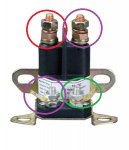
Circled in Red = Batter voltage all the time.
Circled in Purple= Battery voltage when the key is in the start position.
Circled in Green = Ground. This one can be different. Some mowers this is ground all the time. Some mowers it is switched with the key to only have ground when in the start position.
Seat switch normally has nothing to do with the starting circuit. Brake, neutral, and PTO are in the starting circuit. So you need parking brake on, transmission in neutral, and PTO off to start. If you have a Zero Turn you have to have steering handles out.

With your limited knowledge of how the starting circuit works and no assistant, this is going to be a tough nut to crack on your own. I'll try my best to explain what to do, but I'm not very confidant we can get it done. First, you have a three post starter mounted solenoid. Large post, red wire, is positive from battery. Large post, braided wire, transfer wire from solenoid to starter. Small spade post, blue wire, solenoid power wire coming from key switch. You should have a small red wire coming either from the battery post on the solenoid or the positive post on the battery, going to the key switch. This wire powers your system and most times has a fuse inline somewhere. You've never said if you found or checked the fuse. You also did not follow the procedure directions to the letter, which makes it difficult to interpret your answers. Remember we are not standing beside you and your must paint us a very clear picture of what is happening. Also, during this procedure you will only use the volts setting on your meter. Please, repeat the procedure, with no assuming we know or your think anything is good without checking or testing.
I shouldn't say this, but from what you have told us so far, I think you have two problems, which will make this problem even harder to solve. First, with this system, you should not be able to start the engine by jumping accross the two large terminals on the solenoid. If it does start and run this way, your starter bendix is stuck in gear and can cause major damage to your unit if run this way. Second, it does not sound like you have any power to or from the key switch. This is why you have no power on the blue wire or to the clutch.
Don't doubt your ability to solve this problem. You can read and are willing to try, makes a big difference, just slow down and DON'T ASSUME ANYTHING. An assistant would also be a big help, as you only have two hands and short leads on your meter. I've been doing this for way too many years and more than once it will take me more than a day to solve these type of problems. Good luck and let us know if you have more questions. If you do report back, please include the tractor model and serial numbers located under the seat, so we can fid a wiring diagram for your unit.
I shouldn't say this, but from what you have told us so far, I think you have two problems, which will make this problem even harder to solve. First, with this system, you should not be able to start the engine by jumping accross the two large terminals on the solenoid. If it does start and run this way, your starter bendix is stuck in gear and can cause major damage to your unit if run this way. Second, it does not sound like you have any power to or from the key switch. This is why you have no power on the blue wire or to the clutch.
Don't doubt your ability to solve this problem. You can read and are willing to try, makes a big difference, just slow down and DON'T ASSUME ANYTHING. An assistant would also be a big help, as you only have two hands and short leads on your meter. I've been doing this for way too many years and more than once it will take me more than a day to solve these type of problems. Good luck and let us know if you have more questions. If you do report back, please include the tractor model and serial numbers located under the seat, so we can fid a wiring diagram for your unit.
bertsmobile1
Lawn Royalty
- Joined
- Nov 29, 2014
- Threads
- 64
- Messages
- 24,702
How is it ONLY Rivets and I are the only ones to notice the CUT in the BLUE WIRE right above the fuel filter ..????
View attachment 33193
Because when a person I know is competiant is answering a post that I also know how to fix, I just skim through it.
If it is something new I watch carefully so I can learn something.
Too much advice confuses people as we all do the same thing differently.
The OP is having a tough time so no need to confuse him by telling him how to do something 4 different ways.
The blue wire is only a trigger and will work quite fine if only 1 or 2 strands of wire are intact.
But good spot just the same.
When it is over remind him to bind it up to prevent it breaking.
I put some electrical tape around that cut.How is it ONLY Rivets and I are the only ones to notice the CUT in the BLUE WIRE right above the fuel filter ..????
View attachment 33193
With your limited knowledge of how the starting circuit works and no assistant, this is going to be a tough nut to crack on your own. I'll try my best to explain what to do, but I'm not very confidant we can get it done. First, you have a three post starter mounted solenoid. Large post, red wire, is positive from battery. Large post, braided wire, transfer wire from solenoid to starter. Small spade post, blue wire, solenoid power wire coming from key switch. You should have a small red wire coming either from the battery post on the solenoid or the positive post on the battery, going to the key switch. This wire powers your system and most times has a fuse inline somewhere. You've never said if you found or checked the fuse. You also did not follow the procedure directions to the letter, which makes it difficult to interpret your answers. Remember we are not standing beside you and your must paint us a very clear picture of what is happening. Also, during this procedure you will only use the volts setting on your meter. Please, repeat the procedure, with no assuming we know or your think anything is good without checking or testing.
I shouldn't say this, but from what you have told us so far, I think you have two problems, which will make this problem even harder to solve. First, with this system, you should not be able to start the engine by jumping accross the two large terminals on the solenoid. If it does start and run this way, your starter bendix is stuck in gear and can cause major damage to your unit if run this way. Second, it does not sound like you have any power to or from the key switch. This is why you have no power on the blue wire or to the clutch.
Don't doubt your ability to solve this problem. You can read and are willing to try, makes a big difference, just slow down and DON'T ASSUME ANYTHING. An assistant would also be a big help, as you only have two hands and short leads on your meter. I've been doing this for way too many years and more than once it will take me more than a day to solve these type of problems. Good luck and let us know if you have more questions. If you do report back, please include the tractor model and serial numbers located under the seat, so we can fid a wiring diagram for your unit.
I checked the two fuses I have with a ohm meter they tested good. What procedure did I not follow to the letter? I checked everything I was instructed to check, that I knew how to check. As you can see it the photo I posted there is no model number on the seat. All the info I have on the tractor I put in my first post ... 2135 tractor with Kohler engine CH13S 22508 there is a model number and serial number on the transmission, but I think that's the info for the transmission. 618-3081model ... 061280 SN. I will test the key switch. Going by a youtube video.

